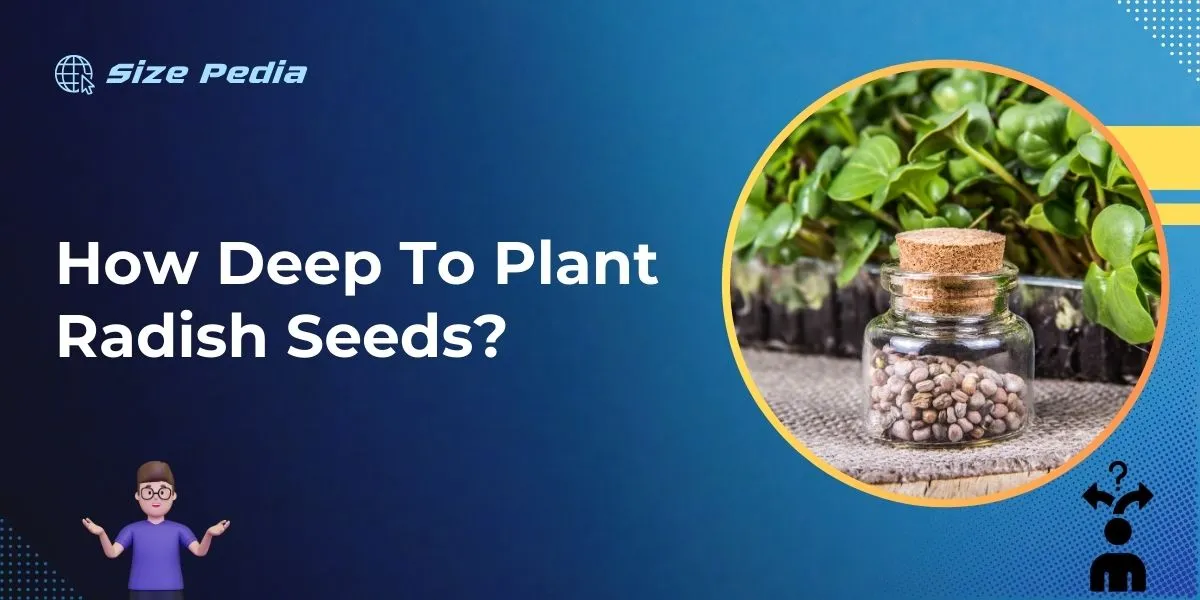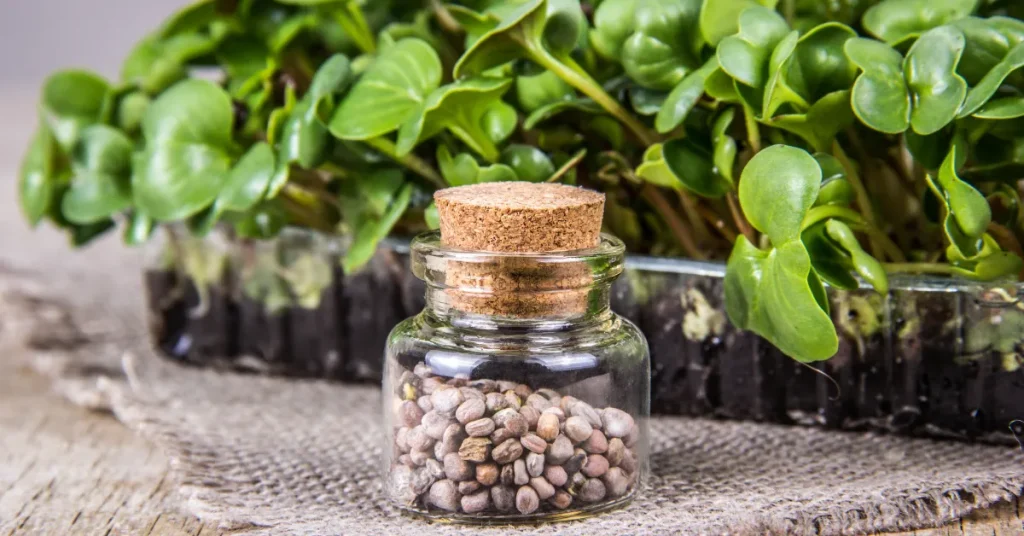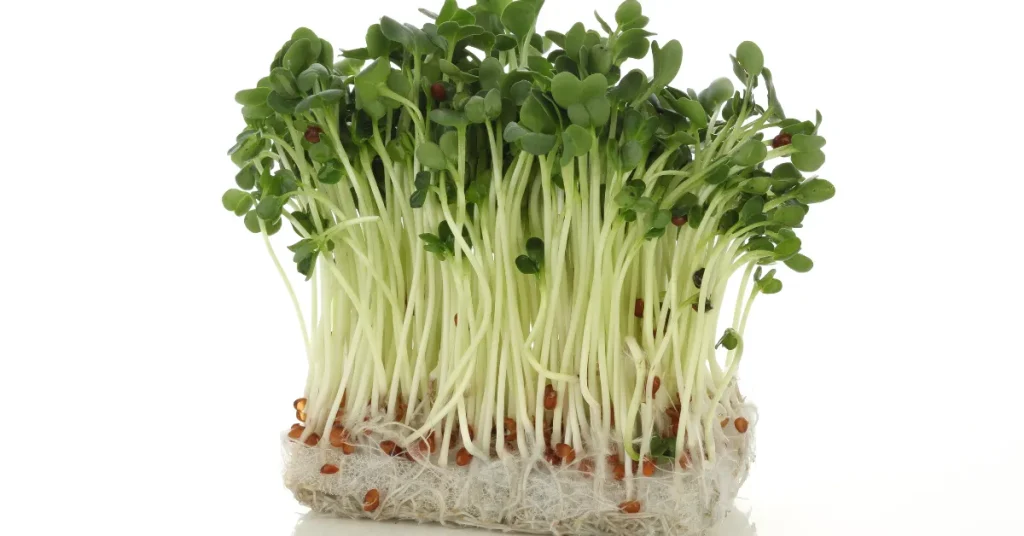Plant radish seeds at a depth of 1/2 inch into the soil. Ensure spacing is about one inch apart for optimal growth.
Growing radishes is a speedy way to add a fresh, crunchy kick to your salads and vegetable platters. Revered for their quick growth period, radishes are a cool-season crop, perfect for spring and fall gardens.
These zesty root vegetables come in a variety of shapes and sizes, from the classic round reds to elongated whites and everything in between.
For gardeners and culinary enthusiasts alike, radishes offer a fuss-free gardening experience and a speedy reward for their minimal effort.
With the right conditions, including well-drained soil and consistent moisture, a radish can go from seed to plate in as little as three weeks, making them an ideal choice for those eager to enjoy homegrown produce without the long wait.

The Importance Of Planting Depth
Getting the planting depth right when seeding is crucial for the successful growth of radishes.
Factors Affecting Seed Germination
Several elements influence how well a seed germinates:
- Soil moisture – too deep, seeds may rot.
- Temperature – cold soils delay germination.
- Air circulation – needed for the seed to breathe.
- Light exposure – some seeds need light to sprout.
- Planting Depth Vs. Seed Size
| Seed Size | Suggested Planting Depth |
| Small seeds (like radishes) | 1/4 – 1/2 inch |
| Larger seeds | 1/2 – 2 inches |
Radish seeds are small and fare best with shallow planting.
Radish Seeds Specifics

Starting a radish garden begins with understanding radish seed specifics. Radish seeds are the tiny packages that contain the potential of crisp, delicious radishes.
Growing radishes from seeds is a simple process, but knowing the right depth for planting can make all the difference. Let’s break down the essentials for those who are eager to enjoy homegrown radishes.
Characteristics Of Radish Seeds
Radish seeds are small, round, and have a reddish-brown hue. They’re packed with growth potential and require the right conditions to thrive. Proper planting is crucial for successful germination.
Generally, radish seeds should be sowed about half an inch (1-2 cm) deep in the soil. This ensures they have enough cover to germinate while preventing them from being planted too deep, which could hinder their growth.
- Size: 1-3 mm in diameter
- Shape: Spherical to oval
- Color: Reddish-brown
- Depth for planting: 0.5 inches (1-2 cm)
Optimal Conditions For Radish Growth
The key to a bountiful radish harvest lies in providing the optimal conditions for growth. Radishes are cool-season crops that prefer temperatures between 50°F (10°C) and 65°F (18°C).
They need plenty of sunlight and moist, well-drained soil to prosper. Ensure the planting site gets around 6-8 hours of sunlight daily for best results.
| Condition | Requirement |
| Temperature | 50°F – 65°F (10°C – 18°C) |
| Sunlight | 6-8 hours daily |
| Soil Type | Rich, well-draining |
| Soil pH | 6.5-7.0 (slightly acidic to neutral) |
Regular watering is essential to keep the soil consistently moist but not waterlogged. Plant in soil with a pH between 6.5 to 7.0. This pH range is ideal for preserving radish flavors.
You can plant radishes in both spring and fall for a continual harvest. For seeds to germinate, ensure the soil is neither too cold nor too hot. Keep an eye on the temperature and soil conditions to maximize your radish yield.
Preparation For Planting
Experts know that a successful harvest of plump, zesty radishes begins long before seeds meet soil. Proper groundwork lays the foundation for a thriving radish crop.
Here, we’ll delve into how to prep your garden bed with soil that radishes love and the ideal timing for planting these crisp, colorful gems.
Soil Preparation
The first step to a bountiful radish harvest is preparing the right soil environment. Radishes prefer a bed that’s as cozy and loose as a sandy beach.
Aim for a soil that’s rich in organic matter with a pH between 6.0 and 7.0. Ensure the ground is free of stones and clumps that could stunt the growth of your radishes.
Adding compost or well-rotted manure boosts the nutrients and enhances the soil structure. Use a rake or garden fork to mix these enhancements into the top six inches, creating a fluffy, welcoming bed for your seeds.
- Test your soil pH; adjustments may be needed.
- Add compost or aged manure to enrich the planting area.
- Loosen the soil to a depth of 6-8 inches to promote proper root expansion.
When To Plant Radishes
Timing is everything when it comes to planting radishes. This cool-season crop flourishes when the days are mild. Plant your seeds four to six weeks before the last expected frost in spring or four to six weeks before the first expected frost in fall.
Radishes sprint from seed to harvest, so you can enjoy their crisp bite in as little as three weeks. To maintain a constant supply, sow radish seeds every two weeks while temperatures stay below 65°F.
| Season | Time Frame | Temperature |
| Spring Planting | 4-6 weeks before last frost | Below 65°F |
| Fall Planting | 4-6 weeks before first frost | Below 65°F |
Maintain even moisture levels after sowing. Protect early spring crops from frost with row covers. For a steady harvest, space plantings two weeks apart.
Planting Techniques
Radishes are the sprinters of the vegetable garden. To enjoy their crisp bite, proper planting is key. Let’s dive into how to plant radish seeds for a bountiful harvest.
Step-by-step Guide To Direct Sowing
Direct sowing means planting seeds straight into the soil. Here’s how:
- Choose a sunny spot with well-draining soil.
- Loosen the soil to about an inch deep.
- Make shallow rows about half an inch deep.
- Drop seeds gently into the rows.
- Cover seeds with a light layer of soil.
- Water the area with a gentle spray.
- Keep the soil moist as seeds germinate.
Spacing And Thinning
Correct spacing helps radishes grow well. Follow these tips:
- Space seeds about an inch apart in rows.
- Rows should be 6 inches apart from each other.
- After germination, thin seedlings to 2 inches apart.
- Thinning ensures enough room for growth.
Use these techniques for radishes that are crisp and tasty!
Post-planting Care

Once your radish seeds are nestled in their beds, the real magic of growth begins. With the right care, your radishes will thrive. Let’s explore the essentials of post-planting care to ensure a bountiful harvest.
Watering Requirements
Radishes love moisture but dislike soggy conditions. Consistent watering is key.
- Water gently to avoid washing away soil covering the seeds.
- Provide 1 inch of water weekly, more if the weather is hot and dry.
- Use a drip irrigation system or water at the soil level to minimize leaf moisture.
- Mulch around plants to help retain soil moisture and regulate temperature.
Weed And Pest Management
Keep your garden beds free from weeds and pests to protect your growing radishes.
| Weed Control | Pest Control |
| Mulch to suppress weed growth.Weed by hand to avoid root damage.Thin seedlings to reduce competition for nutrients. | Inspect plants regularly for signs of pests.Use floating row covers to protect seedlings.Introduce beneficial insects like ladybugs. |
By following these simple steps, your radishes will develop with the best chance for success.
Keep the soil evenly moist and tend to your garden to prevent unwanted guests. With attention and care, you’ll enjoy the crisp taste of homegrown radishes in no time!
Common Mistakes And Solutions
Getting the depth right for radish seeds can make or break your garden’s success. Simple mistakes in planting can lead to poor germination or weak plants. Let’s delve into some common errors gardeners make and how to fix them.
Planting Too Deep Or Too Shallow
Radishes need light to moderate cover.
Be mindful not to bury them too deeply. The ideal planting depth is about half an inch (1.27 cm).
Shallow planting can expose seeds to elements or birds. Follow these steps for perfect depth:
- Make a half-inch furrow with your finger or a tool.
- Drop one to two seeds every inch along the furrow.
- Cover lightly with soil and pat gently.
Use a ruler or a planting guide to avoid going too deep or shallow.
Adjusting To Weather Fluctuations
Radishes can be fickle with temperature changes. They prefer cool soil.
Hot weather can hinder germination. Keep seeds cool by:
- Planting at the right time—early spring or fall.
- Mulching to maintain soil temperature.
- Watering in the morning, avoiding scorching midday sun.
Use a soil thermometer to check if conditions are ideal. They germinate best between 50°F and 68°F (10°C and 20°C).
FAQs About How Deep To Plant Radish Seeds
What Is The Optimal Depth For Planting Radish Seeds?
Radish seeds thrive best when planted at a depth of about half an inch. This allows for sufficient soil coverage without impeding germination. Ensure the soil is well-drained and loose for the best results.
How Far Apart Should I Space Radish Seeds?
Space radish seeds approximately one inch apart. This spacing helps prevent crowding, ensuring adequate room for growth. For rows, maintain a distance of 12 to 18 inches apart to allow for easy maintenance.
Can Radish Seeds Be Direct-sown Outdoors?
Yes, radish seeds can be direct-sown outdoors. They are hardy and prefer cooler weather, making them suitable for early spring or fall planting. Direct sowing also eliminates the stress of transplanting, which radishes can be sensitive to.
What Soil Conditions Do Radishes Need For Success?
Radishes need well-drained, fertile soil with a neutral pH. They prefer soil that is not too rich in nitrogen, which can lead to lush leaves but poor root development. Adding organic matter can improve soil quality for radishes.
Conclusion
Understanding the proper depth for planting radish seeds is key to a bountiful harvest. Ensure a half-inch depth for optimal growth.
Consistency in this simple step can lead to crisp, healthy radishes from your garden. Remember, well-planted seeds are the start of your gardening success story.
Happy planting!
Resources:
1. https://extension.umn.edu/vegetables/growing-radishes
